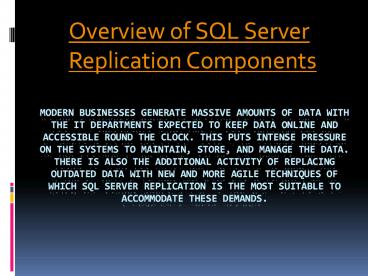SQL server replication tools - PowerPoint PPT Presentation
Title:
SQL server replication tools
Description:
Get BryteFlow Enterprise edition for multiple benefits. Automated real-time data integration to Amazon S3, Redshift, and Snowflake through CDC technology. Reduction in data deployment from months to hours. Self-serve intuitive GUI for transforming and preparing data assets. High availability software with built-in resiliency. Visit website to know more. – PowerPoint PPT presentation
Number of Views:16
Title: SQL server replication tools
1
Modern businesses generate massive amounts of
data with the IT departments expected to keep
data online and accessible round the clock. This
puts intense pressure on the systems to maintain,
store, and manage the data. There is also the
additional activity of replacing outdated data
with new and more agile techniques of which SQL
Server Replication is the most suitable to
accommodate these demands.
- Overview of SQL Server Replication Components
2
What is SQL Server Replication
- SQL Server Replication is a widely-used
technology that helps to copy and distribute data
and database from one source to another. After
completing this activity the process synchronizes
between the databases so that the consistency and
the integrity of the data are maintained. This
process can be programmed to run constantly or at
pre-determined intervals. There are several
replication techniques such as one-way,
one-to-many, many-to-one, and bi-directional, all
of which leads to datasets being in sync with
each other.
3
Types of SQL Server Replication Tools
- There are three distinct types of SQL server
replication tools. - Snapshot ReplicationThis tool simply takes a
snapshot of the data on one server and moves it
to another or another database in the same
server. After the first synchronization snapshot,
it is possible to periodically refresh data in
published tables as per the pre-programmed
schedule. This is the easiest of all replication
tools but comes with a rider - all data has to be
copied each time a table is refreshed. Between
scheduled refreshes in snapshot replication, the
data on the publisher might be different from the
data on the subscriber.
4
- Transactional ReplicationIn transactional
replication, data is copied from the publisher to
the subscriber(s) once and then transactions are
delivered to the subscriber(s) as and when they
take place on the publisher. The initial copy of
the data is transported in a similar process as
snapshot replication where the SQL server takes a
snapshot of data on the publisher and then
forwards it to the subscriber(s). But here, as
and when database users update, insert or delete
records on the publisher, transactions are
forwarded to the subscriber(s).
5
- Merge ReplicationIn this technique, data from
multiple sources are combined into a single
central database. As in transactional
replication, merge replication also uses initial
synchronization through the snapshot of data on
the publisher and moves it to subscribers. But
unlike transactional replication, this method
permits modifications of the same data on
publishers and subscribers, even though
subscribers might not be connected to the
network. Whenever subscribers connect to the
network, merge replication tool will notice it
and combine changes from all subscribers and
change the existing data on the publisher. Of all
SQL server replication tools, merger replication
is very useful if there is a need to modify data
on remote computers even in the absence of
continuous connection to the network.There are
some of the important concepts of SQL server
replication tools.

